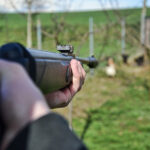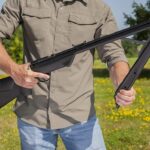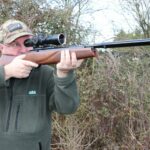One a product of post-Great War ingenuity, and the other a 21st-century upgrade to an already great cartridge. These two cartridges rank very similarly in terms of performance, but one stands out overall. Will the 270 Winchester defend its title as being the trusty hunter’s companion of choice, or will it have to make room for its younger brother, the 270 WSM – In this article, we will analyze and compare both cartridges to see which one is the better cartridge for a hunter.
Table of Contents
History Of The 270 Win
Designed by Winchester, the 270 Win was made available to the public in 1925. As part of the original design, the .30-03 was necked down to a .277 caliber to produce a cartridge ideal for medium to large-sized game.
However, the cartridge alongside the Winchester Model 54 bolt action rifle was not popular initially. This was a result of the recent and profound success of the .30-06 Springfield, which was the hunting cartridge of choice at the time.
It was only after the second world war that the .270 Win gained success and traction in sales. The rise in popularity can be attributed to esteemed gun writer Jack O’Connor who lived and breathed the .270 Win for more than 40 years.
People started to realize that the .270 was the ideal large-sized game hunting cartridge, providing a flatter trajectory than the .30-06.
History Of The 270 WSM
In 2001 Winchester revealed the .3oo WSM to the public, and a year after that, using the .300 WSM as the parent case, the .270 WSM was introduced. The .270 Winchester Short Magnum uses bullets from the already established .270 Win, specifically designed to provide a precise, efficient, and powerful shooting capability in a short-action rifle.
Main Difference Between 270 Win vs 270 WSM

1) Use Cases
Both cartridges are designed for hunting medium to large-sized game at long range. Both cartridges have hunting ammunition with bullet weights of 130 – 150 grain. They provide relatively equal performance at close ranges, with negligible velocity, kinetic energy, and trajectory differences. I found a similar result when I compared the difference between 300 Hamr vs 300 BLK cartridges.
However, the .270 WSM line provides a more powerful platform than its older brother, which is most evident at distances exceeding 300 yards.
Nonetheless, both are capable and excellent for big game such as moose and elk, with the grizzly and black bear also ideal targets at closer range. Yet, I would prefer the .270 Winchester at all ranges up to 300 yards and the 270 WSM for 300+ yards.
2) Size Comparison
The .270 Winchester:
- Parent case – .30-06
- Bullet diameter – .277 in (7.0 mm)
- Land diameter – .270 in (6.9 mm)
- Neck diameter – .308 in (7.8 mm)
- Shoulder diameter – .441 in (11.2 mm)
- Base diameter – .470 in (11.9 mm)
- Rim diameter – .473 in (12.0 mm)
- Case length – 2.540 in (64.5 mm)
- Overall length – 3.340 in (84.8 mm)
- Case capacity – 67 gr H2O (4.3 cm3)
- Rifling twist – 1-10 in (250 mm)
- Primer type – Large rifle
- Maximum pressure (SAAMI) – 65,000 psi (450 MPa)
The 270 WSM:
- Parent case – .30o WSM
- Bullet diameter – .277 in (7.0 mm)
- Land diameter – .270 in (6.9 mm)
- Neck diameter – .3140 in (7.98 mm)
- Shoulder diameter – .5381 in (13.67 mm)
- Base diameter – .555 in (14.1 mm)
- Rim diameter – .535 in (13.6 mm)
- Case length – 2.1 in (53.3 mm)
- Overall length – 2.860 in (72.6 mm)
- Case capacity – 67 gr H2O (4.3 cm3)
- Rifling twist – 1-10 in (250 mm)
- Primer type – Large rifle magnum
- Maximum pressure (SAAMI) – 65,000 psi (450 MPa)
Just like we saw in our analysis of the .17 vs .22 rounds, size is important. As the name suggests and is evident from the above data, the short-action .270 WSM is a much shorter and fatter cartridge than the .270 Winchester. Having the .30-06 as a parent case would naturally mean that the long action .270 Winchester would have a long overall length. Both of these rounds are similar in size to the .338 norma vs .338 lapua cartridges!
3) Ballistic Comparison
Using a 24″ barrel for both cartridges and both loaded with 130-grain bullet weight Winchester ammo, the 270 Winchester with Deer Season XP and the 270 Wsm with Super X:
Velocity (FPS):
The 270 WSM:
- Muzzle Velocity – 3,275
- 100 Yards – 2,996
- 200 Yards – 2,734
- 300 Yards – 2,487
- 400 Yards – 2,253
- 500 Yards – 2,032
The 270 Winchester:
- Muzzle Velocity – 3,060
- 100 Yards – 2,848
- 200 Yards – 2,642
- 300 Yards – 2,447
- 400 Yards – 2,261
- 500 Yards – 2,082
Just like when we compared the 223 Rem vs 30-36 ammo, muzzle velocity was an important deciding factor!
Energy (FT-LBS):
The 270 WSM:
- Muzzle Energy – 3,096
- 100 Yards – 2,591
- 200 Yards – 2,157
The 270 Winchester:
- Muzzle Energy – 2,706
- 100 Yards – 2,338
- 200 Yards – 2,015
- 300 Yards – 1,729
- 400 Yards – 1,475
- 500 Yards – 1,252
Unlike our analysis of the 17 and 223 Rem, the muzzle energy was very similar in these rounds. Both are capable of producing a large amount of force.
Trajectory (in):
The 270 WSM:
- 100 Yards – 0
- 200 Yards – -2.4
- 300 Yards – -9.4
- 400 Yards – -22.1
- 500 Yards – -35.7 (zeroed at 200 yards)
The 270 Winchester:
- 100 Yards – 0
- 200 Yards – -2.7
- 300 Yards – -10.2
- 400 Yards – -23.4
- 500 Yards – -37.6 (zeroed at 200 yards)
As the ballistics data reveals, the .270 WSM outperforms the .270 Winchester in almost every aspect. With higher initial energy and maintaining more energy for a longer range than the 270 WSM. Also, having a better trajectory with less bullet drop at all distances makes it more accurate. Just like we saw in our analysis of the 350 Legend and 223 rounds, bullet drop is a major factor.
However, the velocities are quite similar, although the 270 WSM has a higher muzzle velocity, the 270 Winchester slightly has a higher velocity at ranges of 300+ yards. The speed of a bullet largely depends on bullet weight.
The same ballistic results can be expected when comparing other loads with heavier bullet weights.
Can You Shoot 270 WSM In A 270 Win?
Theoretically, yes, you can. But you should never attempt it, the shorter and fatter cartridge will give you a hard time chambering it and possibly damage your guns. Most rifles chambered the ammo with very great difficulty.
Which Is Best For Hunters?

When only looking at the numbers, I would say go for the .270 WSM, but when I took both rifles out to the field, I began to sing another rhyme. I experienced constant feeding problems with the .270 WSM regardless that it was quality ammo. The recoil experienced by the .270 WSM is also much higher than the .270 Winchester. Not to even mention the shortage of .270 WSM ammunition, as is the case with most new cartridges. Just like we saw with the 300 Blk & 6.5 Grendel ammo, some rounds can be hard to find.
So, if your main shooting goal is to shoot predominantly long-range shots and recoil is not a problem for you, then the rifle you should carry would be a .270 WSM. However, for most shooters, the advantage of having an abundance of ammo in circulation and still providing similar excellent accuracy makes the appeal of the .270 Winchester worthwhile. If you want to check out a round with very high recoil, check out the .50 GI or .50 AE rounds!
Frequently Asked Questions
Final Thoughts
Both these cartridges have excellent track records, but the .270 Winchester still proves to be the one to beat. The fact that the .270 WSM has feeding problems and ammunition is scarcer than a hen’s teeth makes the slightly better ballistics negligible when deciding which cartridge is the better hunter’s companion. Still, if you are looking for something different, then the short-action .270 WSM is one to consider. As for me, I will stick with my trusty .270 Winchester!















































